Viral Inactivation Market Size
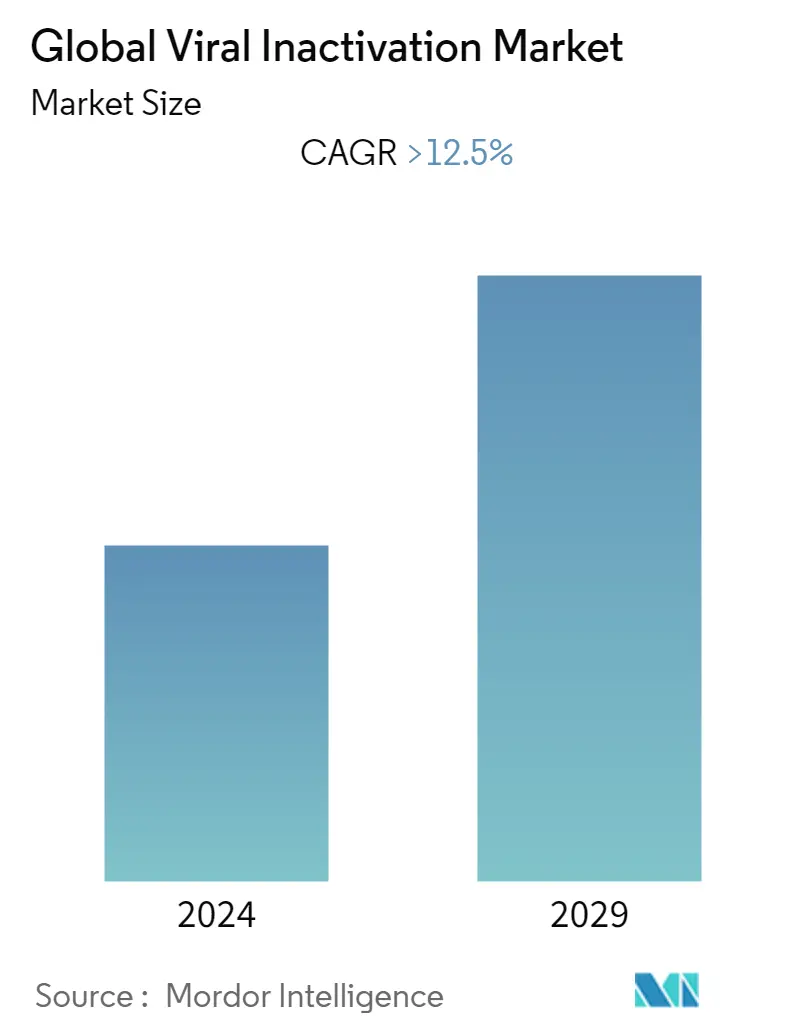
| Study Period | 2019 - 2029 |
| Base Year For Estimation | 2023 |
| CAGR | 12.50 % |
| Fastest Growing Market | Asia Pacific |
| Largest Market | North America |
| Market Concentration | Medium |
Major Players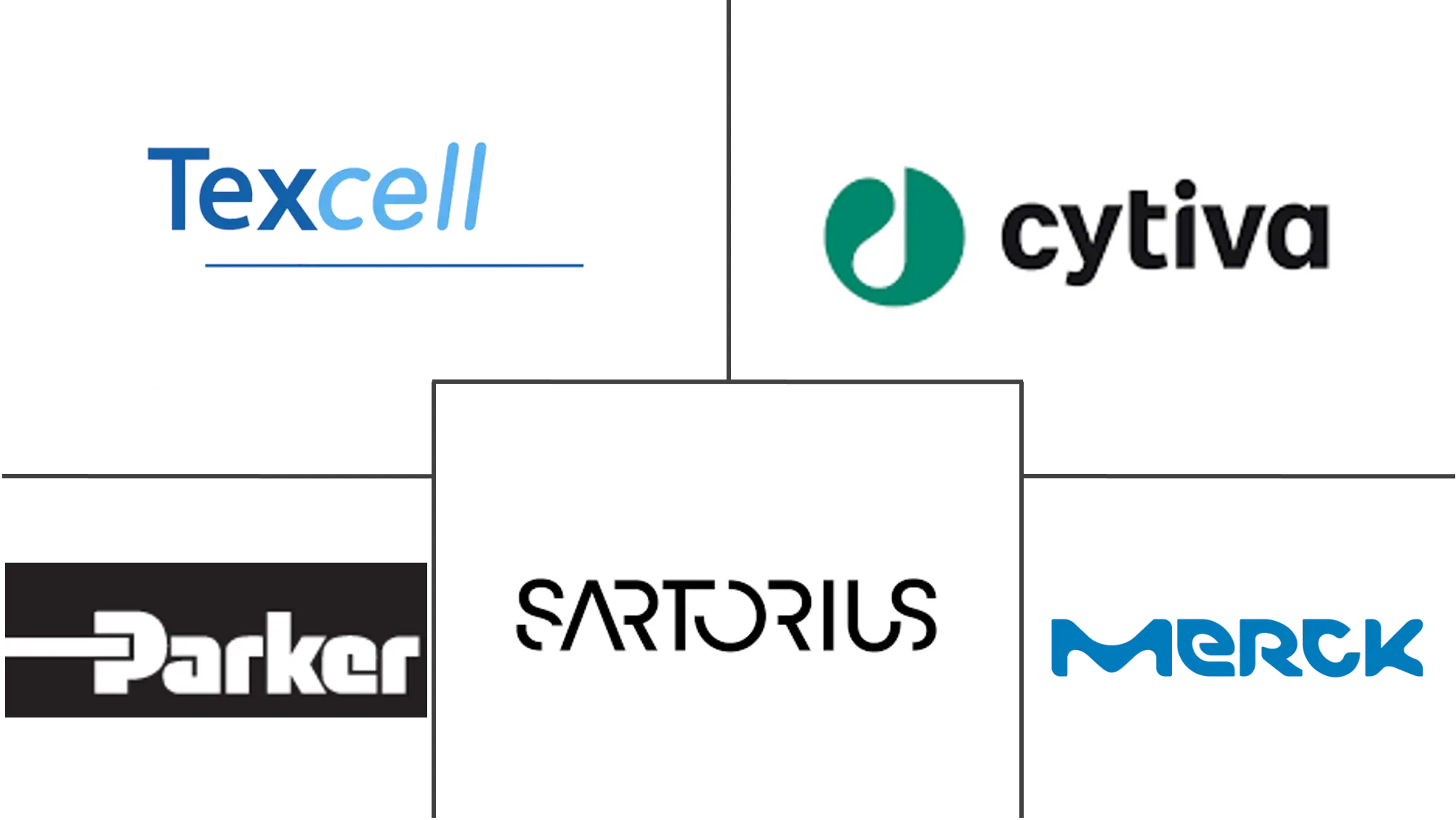
*Disclaimer: Major Players sorted in no particular order |
Viral Inactivation Market Analysis
The viral inactivation market is poised to grow at a CAGR of 12.5 % over the forecast period.
The outbreak of COVID-19 has turned the spotlight on the studied market as most of the biopharmaceutical players are involved in the development of novel therapeutics against the SARS-CoV2 virus. However, the research and development activities of non-COVID-19 drugs have slowed down due to the stringent guidelines by the regulatory authorities during the pandemic. According to a study that was published in the American Chemical Society Pharmacology and Translational Science, 2020, new potential therapeutics for COVID-19 that were discovered using a combined virtual and experimental screening strategy and chosen from among the medications that were already in use were examined to check for structural similarity against a library of almost 4000 medications that were already in use, with hydroxychloroquine (HCQ) serving as a reference medication. The study suggested remdesivir and favipiravir therapies as prospective adjuvants in COVID-19 treatment as well as zuclopenthixol, nebivolol, and amodiaquine as potential candidates for clinical trials against the early phase of the SARS-CoV-2 infection. Additionally, more than 1000 clinical trials are currently being conducted to repurpose FDA-approved medications and evaluate the safety and efficacy of investigational antiviral compounds in the fight against COVID-19, according to the study Drug Discovery of Small Molecules for the Treatment of COVID-19: A Review on Clinical Studies in 2021. This review concentrates on the potential of currently available FDA-approved medications and molecules that are in the clinical pipeline to treat viral infections like HIV, hepatitis B, Ebola virus, and other coronavirus family viruses because new medications can take months to years to develop and reach the market (SARS-CoV and MERS-CoV). Thus, the market was adversely affected by the pandemic.
The major factors attributing to the growth of the viral inactivation market are a rise in the global prevalence of chronic diseases like cancer, autoimmune disorders, and other diseases along with an increase in healthcare expenditure. Globocan 2020 reported that in 2020, the 5-year prevalence of all types of cancers in both sexes is 2,166,740 in Africa. It has also been reported that out of these cases, 1,298,101 cases were reported in females and 868,639 cases were reported in males of all ages. Such a large prevalence of cancer is driving the growth of the market over the forecast period. Additionally, the same source also reported the 5-year prevalence of cancer cases in Saudi Arabia there are about 82,640 cases of all types of cancer in both sexes and out of which 39,241 cases were reported in males and 43,399 cases in females in 2020. Rising approvals from Food and Drug applications for drug candidates are also expected to drive the growth of the studied market. For instance, according to the data published on Mid-Year Review: New Drug Approvals in June 2021, the United States Food and Drug Administration's (FDA) Center for Drug Evaluation and Research (CDER) has authorized 26 New Molecular Entity's (NMEs) at the halfway point of 2021 (as of June 28, 2021), which was on par with the full-year 2020 approval rate of 53 NMEs. Except for 2018, when 59 NMEs were granted, the number of NMEs approved in 2020 was the second most in the last decade. The rising approvals from FDA will further boost the research and development activities, which will in turn need toxicology screening studies which are expected to increase the adoption of viral inactivation technologies, thereby expected to propel the growth of this market. Thus, the above-mentioned factors are expected to increase market growth.
Viral Inactivation Market Trends
This section covers the major market trends shaping the Viral Inactivation Market according to our research experts:
Vaccines and Therapeutics Segment is Expected to Hold the Largest Market Share in the Viral Inactivation Market
The vaccines and therapeutics segment is anticipated to hold the largest market share in the viral inactivation market. The highest market revenue is due to higher incidences and the huge economic burden of chronic diseases such as Cancer, which demanded the inactivated vaccines along with increasing government support for pharmaceutical and biotechnology industries to invest in the R&D of novel therapeutics. According to International Agency for Research on Cancer (Globocan) 2020 figures, 495,773 new pancreatic cancer cases were diagnosed worldwide in 2020. The figures from GLOBOCAN 2020 also pointed out that the incidence of new pancreatic cancer cases in very high HDI (Human Development Index) countries was recorded at 275,036, followed by 187,205 in high HDI countries. Medium and low HDI countries had 24,705 and 8,586 cases, respectively. Similarly, increasing initiatives by market players are expected to increase the market growth. . In March 2022, Singapore-based biopharmaceutical company Prestige Biopharma (PBP) announced that its Innovative Discovery Centre (IDC) is under construction in Busan, South Korea. The IDC will lead PBP's future vision through activities such as the development of antibody therapeutics, including pancreatic cancer treatment, and cutting-edge vaccine technology. There are also plans to introduce vaccines that can be used to treat pancreatic cancers. In October 2020, scientists from the Francis Crick Institute, London, United Kingdom presented an experimental immunotherapy-based vaccine that specifically targets the KRAS gene that is involved in the development of many types of cancer. Thus, the abovementioned factors are expected to increase the market growth.
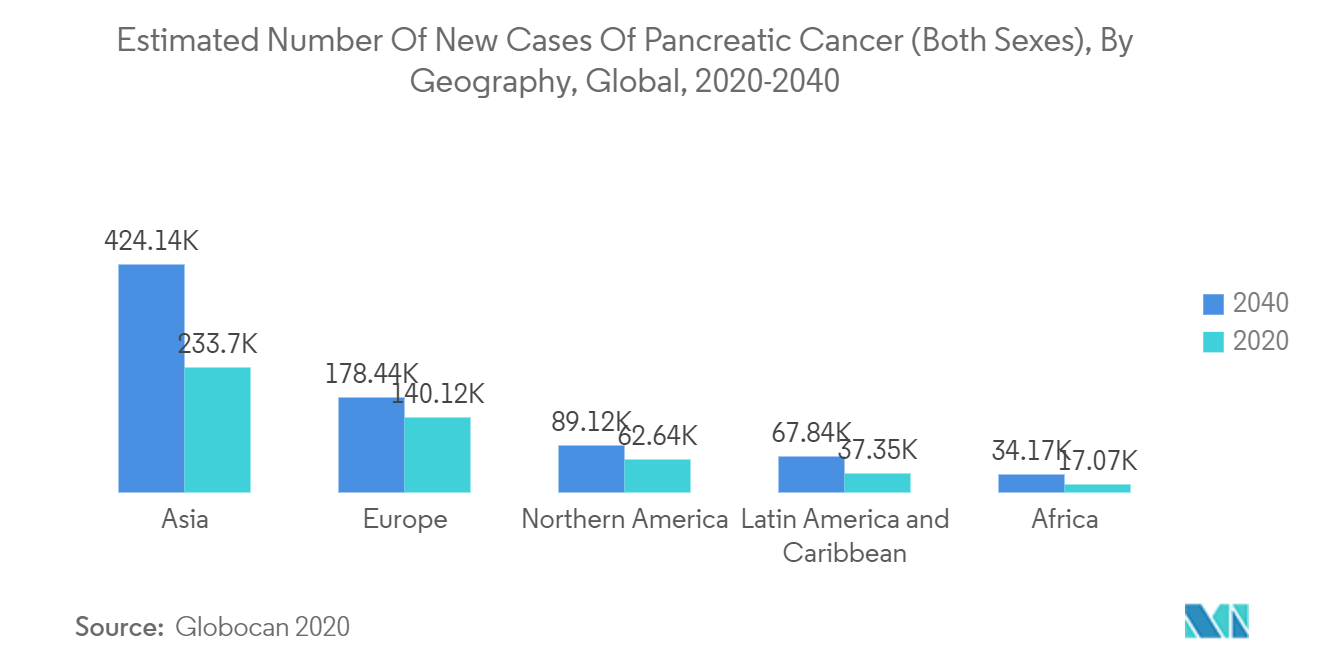
North America is Expected to Dominate the Market Over the Forecast Period
North America is expected to dominate overall market, throughout the forecast period. In North America, the United States holds the largest market share in terms of revenue. Also, advanced healthcare infrastructure, the presence of major pharmaceutical and biopharmaceutical companies, and significant healthcare R&D expenditure by the government and companies in the United States are the key factors estimated to fuel the market in North America. According to ClinicalTrial.gov, Canadian pharmaceutical companies and research institutions had robust R&D pipelines in 2021, with 5,659 new studies in various stages of evaluation, 1,397 (24%) of which were in Phase III clinical trials approved by the food and drug administration (FDA) or EMA (European Medicines Agency), representing a wide range of therapeutic areas, and this condition will boost the market growth in the country. The Canadian government's Plan to Mobilize Science in 2020 includes USD 192 million for coronavirus research and medical countermeasures and also the government has invested up to USD 56 million to support clinical trials for a COVID-related vaccine candidate from Variations Biotechnologies Inc. Similarly, Mexico aims to strengthen pharmaceutical research and manufacturing in the long term in 2021 reported that Mexico plans to release its National Pharmaceutical Policy in April 2022, which will address a variety of supply chain and regulatory challenges, and the framework collaboration agreements signed by Mexico will strengthen scientific research and foster pharmaceutical innovation, and this will help in increase of drug discoveries in the country, thus increase the demand for viral inactivation. Moreover with new funding from Michigan Drug Discovery in 2021, researchers from throughout the University of Michigan are looking into ways to manage pain, cancer, and infection. In which four of the five studies will look for novel biologically active compounds that can be used to target crucial drug discovery targets, and this drives the market. Hence, owing to the above conditions the studied market is expected have a faster growth over the forecast period.
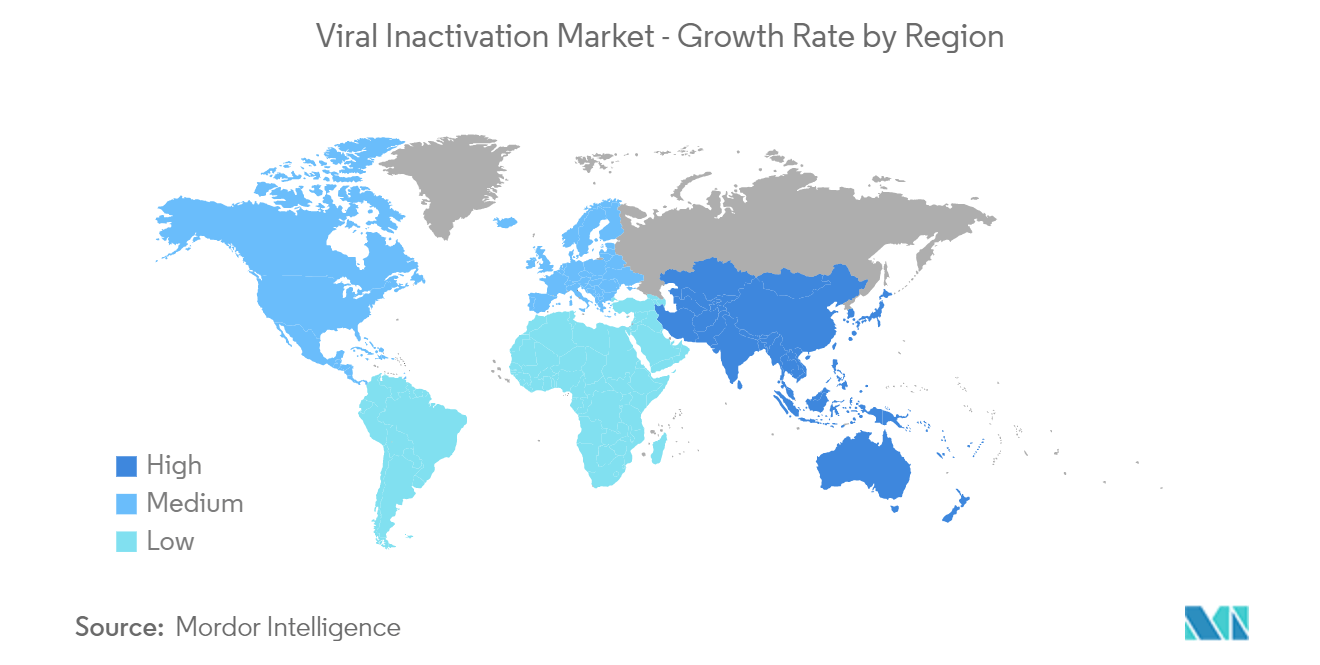
Viral Inactivation Industry Overview
The viral inactivation market is moderately consolidated, and competitive and consists of several major players. In terms of market share, a few of the major players are currently dominating the market with various development strategies. Some prominent players are making acquisitions and effective mergers to consolidate their market positions across the globe. Furthermore, new entrants are expected to enter the market with innovative product pipelines and continuous technological innovations that increase the market revenue over the forecast period. Some of the major market players are Cytiva (Danaher Corporation), Merck KGaA, Parker Hannifin Corp, Sartorius AG, and Texcell SA among others.
Viral Inactivation Market Leaders
-
Merck KGaA
-
Sartorius AG
-
Texcell SA
-
Cytiva (Danaher Corporation)
-
Parker Hannifin Corp
*Disclaimer: Major Players sorted in no particular order
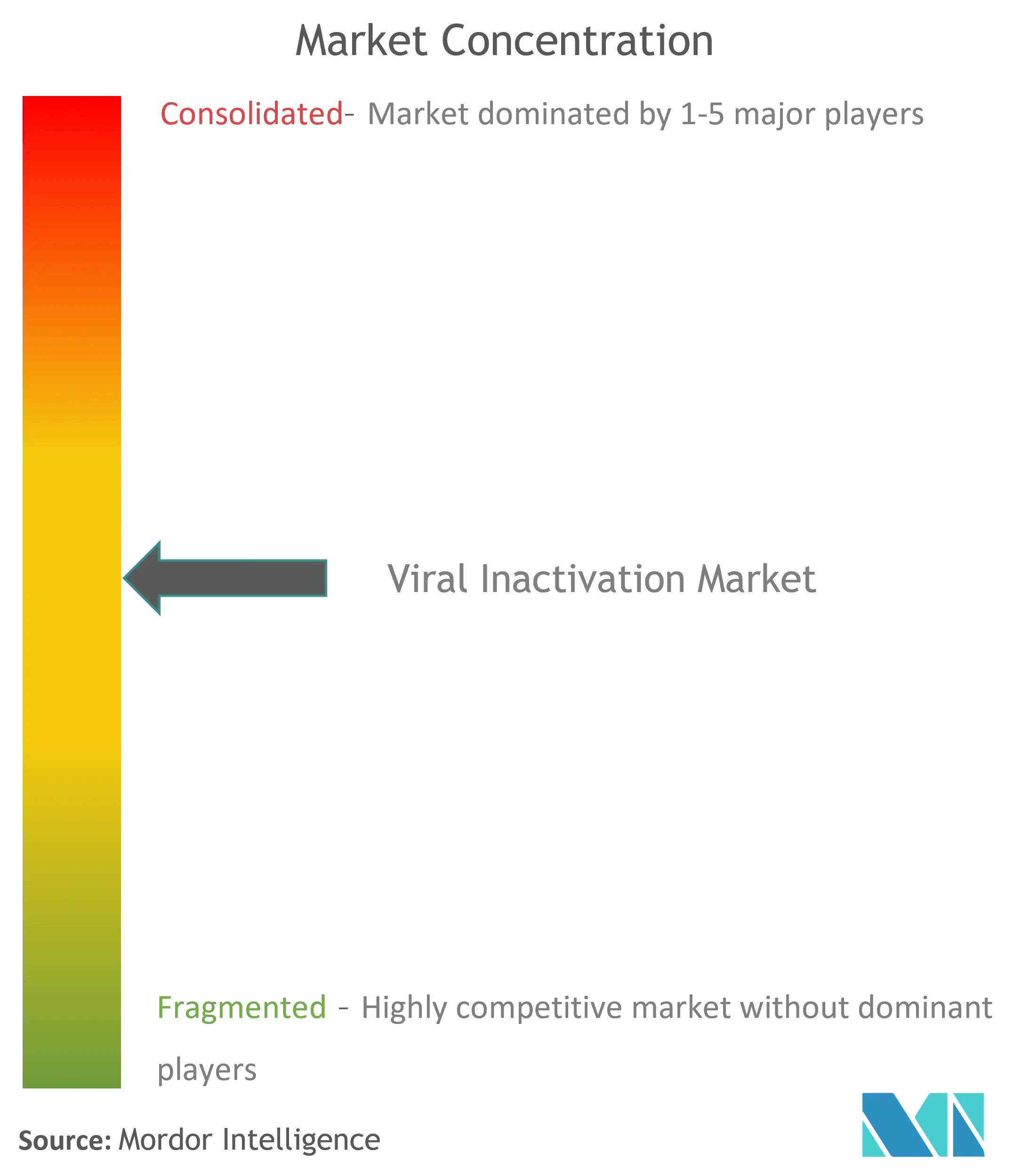
Viral Inactivation Market News
- In March 2022, the InhibiSURE Viral Inactivation Medium recipe was created by Thermo Fisher Scientific to be non-hazardous. a brand-new viral transport medium that makes it possible to transfer and quickly inactivate the SARS-CoV-2 virus while also stabilizing viral RNA for use in in vitro diagnostic testing methods.
- In February 2022, HPG Co., Ltd. developed a highly concentrated catechin EGCg (Epigallocatechin Gallate) formulation technology that is water soluble and has excellent storage stability. The company has also started the process of filing a patent application for the technology to stabilize the product at a high concentration in an aqueous solution. It has an impact that renders certain influenza viral components inactive.
Viral Inactivation Market Report - Table of Contents
1. INTRODUCTION
- 1.1 Study Assumptions and Market Definition
- 1.2 Scope of the Study
2. RESEARCH METHODOLOGY
3. EXECUTIVE SUMMARY
4. MARKET DYNAMICS
- 4.1 Market Overview
-
4.2 Market Drivers
- 4.2.1 Rapid Growth in Pharmaceutical and Biotechnology Industries and Strong R&D Investments
- 4.2.2 Increasing Number of New Drug Launches with Increased Government Support
-
4.3 Market Restraints
- 4.3.1 Highly Expensive Manufacturing Processes of Biosimilars
- 4.3.2 Complex Regulatory Framework for Validation of Inactivated Products
-
4.4 Porter's Five Force Analysis
- 4.4.1 Threat of New Entrants
- 4.4.2 Bargaining Power of Buyers/Consumers
- 4.4.3 Bargaining Power of Suppliers
- 4.4.4 Threat of Substitute Products
- 4.4.5 Intensity of Competitive Rivalry
5. MARKET SEGMENTATION (Market Size by Value - USD million)
-
5.1 By Method
- 5.1.1 Solvent Detergent Method
- 5.1.2 pH Adjustment Method
- 5.1.3 Pasteurization
- 5.1.4 Others
-
5.2 By Product
- 5.2.1 Viral Inactivation Systems and Accessories
- 5.2.2 Kits and Reagents
- 5.2.3 Others
-
5.3 By Application
- 5.3.1 Vaccines and Therapeutics
- 5.3.2 Blood & Blood Products
- 5.3.3 Cellular & Gene Therapy Products
- 5.3.4 Others
-
5.4 By End User
- 5.4.1 Pharmaceutical and Biotechnology Companies
- 5.4.2 Contract Research Organisations
- 5.4.3 Others
-
5.5 Geography
- 5.5.1 North America
- 5.5.1.1 United States
- 5.5.1.2 Canada
- 5.5.1.3 Mexico
- 5.5.2 Europe
- 5.5.2.1 Germany
- 5.5.2.2 United Kingdom
- 5.5.2.3 France
- 5.5.2.4 Italy
- 5.5.2.5 Spain
- 5.5.2.6 Rest of Europe
- 5.5.3 Asia-Pacific
- 5.5.3.1 China
- 5.5.3.2 Japan
- 5.5.3.3 India
- 5.5.3.4 Australia
- 5.5.3.5 South Korea
- 5.5.3.6 Rest of Asia-Pacific
- 5.5.4 Middle-East and Africa
- 5.5.4.1 GCC
- 5.5.4.2 South Africa
- 5.5.4.3 Rest of Middle-East and Africa
- 5.5.5 South America
- 5.5.5.1 Brazil
- 5.5.5.2 Argentina
- 5.5.5.3 Rest of South America
6. COMPETITIVE LANDSCAPE
-
6.1 Company Profiles
- 6.1.1 Charles River Laboratories, Inc.
- 6.1.2 Clean Cells
- 6.1.3 Cytiva (Danaher Corporation)
- 6.1.4 Merck KGaA
- 6.1.5 Mettler Toledo
- 6.1.6 Parker Hannifin Corp
- 6.1.7 Rad Source Technologies Inc
- 6.1.8 Sartorius AG
- 6.1.9 Texcell SA
- 6.1.10 Vironova AB
- 6.1.11 WuXi PharmaTech
- *List Not Exhaustive
7. MARKET OPPORTUNITIES AND FUTURE TRENDS
** Subject To AvailablityViral Inactivation Industry Segmentation
As per the scope of the report, viral inactivation is a method of viral processing, where the final product may contain the viruses in an inactive form. The Virus inactivation process is a critical step in process development for biologicals such as tissue and tissue products, stem cell products, and vaccines, and therapeutics. The viral inactivation market is segmented by method (solvent detergent method, ph adjustment method, pasteurization, and others), product (viral inactivation systems and accessories, kits and reagents, and others), application (vaccines and therapeutics, blood & blood products, cellular & gene therapy products, and others), end-user (pharmaceutical and biotechnology companies, contract research organisations, and others), and geography (North America, Europe, Asia-Pacific, Middle-East and Africa, and South America). The market report also covers the estimated market sizes and trends for 17 different countries across the major regions globally. The report offers the values (USD million) for the above segments.
| By Method | Solvent Detergent Method | |
| pH Adjustment Method | ||
| Pasteurization | ||
| Others | ||
| By Product | Viral Inactivation Systems and Accessories | |
| Kits and Reagents | ||
| Others | ||
| By Application | Vaccines and Therapeutics | |
| Blood & Blood Products | ||
| Cellular & Gene Therapy Products | ||
| Others | ||
| By End User | Pharmaceutical and Biotechnology Companies | |
| Contract Research Organisations | ||
| Others | ||
| Geography | North America | United States |
| Canada | ||
| Mexico | ||
| Geography | Europe | Germany |
| United Kingdom | ||
| France | ||
| Italy | ||
| Spain | ||
| Rest of Europe | ||
| Geography | Asia-Pacific | China |
| Japan | ||
| India | ||
| Australia | ||
| South Korea | ||
| Rest of Asia-Pacific | ||
| Geography | Middle-East and Africa | GCC |
| South Africa | ||
| Rest of Middle-East and Africa | ||
| Geography | South America | Brazil |
| Argentina | ||
| Rest of South America |
Viral Inactivation Market Research FAQs
What is the current Global Viral Inactivation Market size?
The Global Viral Inactivation Market is projected to register a CAGR of greater than 12.5% during the forecast period (2024-2029)
Who are the key players in Global Viral Inactivation Market?
Merck KGaA, Sartorius AG, Texcell SA, Cytiva (Danaher Corporation) and Parker Hannifin Corp are the major companies operating in the Global Viral Inactivation Market.
Which is the fastest growing region in Global Viral Inactivation Market?
Asia Pacific is estimated to grow at the highest CAGR over the forecast period (2024-2029).
Which region has the biggest share in Global Viral Inactivation Market?
In 2024, the North America accounts for the largest market share in Global Viral Inactivation Market.
What years does this Global Viral Inactivation Market cover?
The report covers the Global Viral Inactivation Market historical market size for years: 2019, 2020, 2021, 2022 and 2023. The report also forecasts the Global Viral Inactivation Market size for years: 2024, 2025, 2026, 2027, 2028 and 2029.
Global Viral Inactivation Industry Report
Statistics for the 2024 Global Viral Inactivation market share, size and revenue growth rate, created by Mordor Intelligence™ Industry Reports. Global Viral Inactivation analysis includes a market forecast outlook to 2029 and historical overview. Get a sample of this industry analysis as a free report PDF download.



